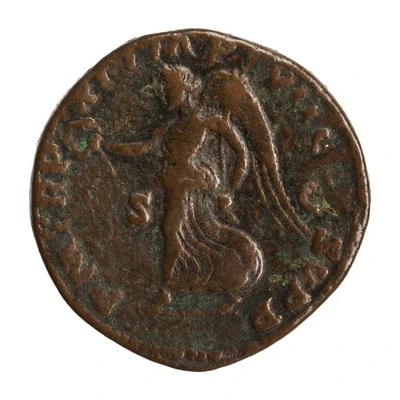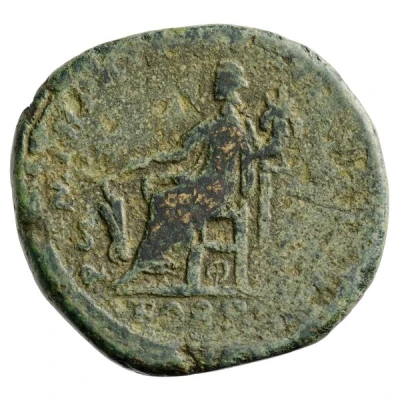


© American Numismatic Society (ANS)
Dupondius - Commodus P M TR P XI IMP VII COS V P P S C; Victory
186 year| Bronze | 13.3 g | 23 mm |
| Issuer | Rome › Roman Empire (27 BC - 395 AD) |
|---|---|
| Emperor | Commodus (Lucius Aurelius Commodus) (177-192) |
| Type | Standard circulation coin |
| Year | 186 |
| Value | 1 Dupondius = ⅛ Denarius |
| Currency | Denarius, Reform of Augustus (27 BC – AD 215) |
| Composition | Bronze |
| Weight | 13.3 g |
| Diameter | 23 mm |
| Shape | Round (irregular) |
| Technique | Hammered |
| Demonetized | Yes |
| Updated | 2024-10-06 |
| Numista | N#265859 |
|---|---|
| Rarity index | 100% |
Reverse
Victory, winged, draped, advancing left, holding wreath in extended right hand and palm sloped over left shoulder in left hand.
Script: Latin
Lettering: P M TR P XI IMP VII COS V P P S C
Translation:
Pontifex Maximus, Tribunicia Potestate Undecima, Imperator Septimum, Consul Quintum, Pater Patriae. Senatus Consultum.
High priest, holder of tribunician power for the eleventh time, supreme commander (Imperator) for the seventh time, consul for the fifth time, father of the nation. Decree of the senate.
Comment
Mass varies: 11.76–14.81 g;Example of this type:
American Numismatic Society (ANS)
Source:
Online Coins of the Roman Empire (OCRE)
Interesting fact
One interesting fact about this coin is that it features an image of the Roman goddess Victory on the reverse side, which was a common motif on Roman coins during the reign of Commodus. The image of Victory was meant to symbolize the Roman Empire's military prowess and its ability to conquer and dominate other nations. The fact that this coin was made of bronze, a relatively inexpensive metal, suggests that it was intended for everyday use by ordinary people, rather than being a high-value coin reserved for the wealthy elite. Additionally, the fact that it weighs 13.3 grams suggests that it was a significant size for a coin, making it easily recognizable and convenient to handle in transactions.

